Jade River: A History of the Mahurangi
Ronald H LockerFirst published 2001. Published online 2014–. This online edition is a work in progress…
Pages 113–119in printed edition
Art of the chartmakers Cudlip Pudsey-Dawson et al
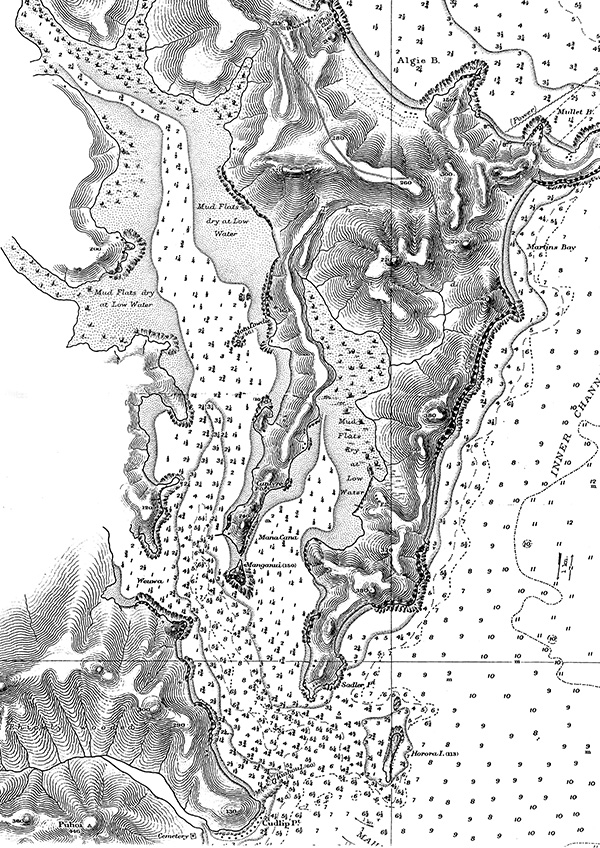
Marine Cartographic Work of Art: The pen of the pre-digital cartographer was lavished on the Mahurangi Harbour by Captain Willoughby Pudsey-Dawson, working aboard the coal-fired, steam-powered war-sloop hms Penguin. cartographer Captain Willoughby Pudsey-Dawson
During his voyages of 1833, Henry Williams records scrambling to the south end of Kawau:
…to take bearings of the various islands points etc. around us…
…and climbing Motutapu to take similar bearings around the Waitematā. We are reminded that the charts we take for granted—much less, beacons—were not enjoyed by those missionary seafarers, as they braved the northeast coasts in frail craft. Williams probably had the old missionary chart of Northern New Zealand, drawn in 1819, and a distinct liability on the Rodney coast.
The charting of Mahurangi had to wait until the Hauraki Gulf was charted. Cook, the first captain to enter the gulf, named it the River Thames. When he left sailing northwards, he sketched in the headlands of islands and main, but left them floating in a blank area around the present Mahurangi coast. On 24 November 1769, off Cape Rodney in not untypical weather, he wrote in his log:
A strong gale and squally blowing right off the land, which would not permit us to come near it—we had a slight but distant view of the coast and was not able to distinguish whether the points we saw were parts of the Main or Islands lying before it—At noon—not above 2 miles from a point of land on the Main and 3½ leagues from a very high Island which lies NEBE from us—The point of land we are now abreast of I take to be the NW extremity of the River Thames, for I shall comprehend under that name the deep bay we have been in for the week past—the NE point of which—I have named Cape Colville—the NW point of the River, which I have named Point Rodney, lies WNW 9 leagues from Cape Colville, Latitude 36 15′ S. Long 174 58′ West.
So Cape Rodney was fixed in position on the globe. Its name passed to the county, then to subsequent administrative areasRodney District Council; subsumed into Auckland Council 2010, as Rodney Ward and Rodney Local Board area. Today few residents have any notion of who Rodney was. Cook was following the tradition of naval cartographers in affixing the names of Lords of the Admiralty, admirals, or of their own officers to the features they mapped. George Bridges Rodney (1719–92) was one of the most distinguished admirals of the day. In 1759 he had destroyed in Le Havre, a flotilla intended for the invasion of England. Ten years after Cook visited New Zealand, Rodney defeated the Spanish fleet off Cape St Vincent, and in 1782 he defeated the combined Spanish and French fleets off Dominica, thus securing to Britain its West Indian colonies, and for himself, a peerage and a pension of £2000.
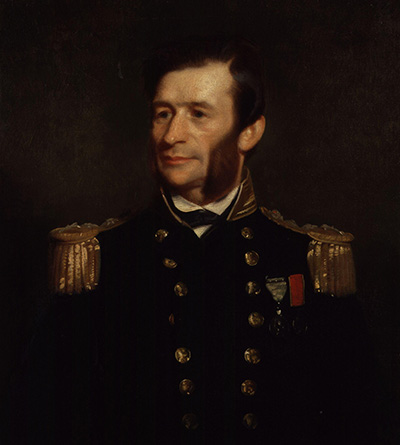
One Richards in Deed: One of the cartographers mentioned by Dr Ronald Locker, he refers to as ‘one Richards’. Although Dr Locker used a computer to write his manuscript—an early Amstrad personal word processor—he had no access to the internet, much less to a search engine, and much of his research was conducted onsite at libraries scouring through microfilmed records. Richards, it transpires, was none other than Sir George Henry Richards, whose deeds qualify him to be categorised as a worthy successor to the great George Vancouver. artist Stephen Pearce
In 1801 Captain Wilson of the spar ship hms Royal Admiral produced a more detailed chart of the Hauraki Gulf, but again weak on the Rodney coast.
So far Mahurangi had remained hidden behind Saddle IslandTe Hapa Island, from these transient cartographers, although it was probably already in use by whalers and traders. It fell to Captain James Downie, commander of the storeship hms Coromandel to be the first to chart the harbour, and perhaps the first European to enter it. Marsden had come south with the ship. While it was loading spars in the harbour that bears its name, the indefatigable priest set out westwards in a whaleboat, becoming the first European to enter and explore the Waitematā, in July 1820. The next month, Captain Kent in the Prince Regent sailed down the Rangitoto and Waiheke Channels, calling them collectively the Prince Regent Channel. When the hms Coromandel sailed for Port Jackson the next year, it cruised up through Whangaparāoa Passage and anchored on 19 May 1821 off Waiwera, and sent a whaleboat in. Māori guides were obviously employed, since Downie noted on his chart the Hot Springs, the “Mourangi Rock and Bay” (apparently applied to the whole bight, Whangaparāoa to Kawau). Between the springs and the island he notes “A small River, Cowrie reported to grow on its banks” (the Waiwera). A boat was sent in to explore the Mahurangi Harbour. A single line of soundings runs down its centre, as far as Schoolhouse Bay, and an anchorage in seven fathoms is marked off Casnell Island. The western shore is described as “Woody Hills of moderate elevation”, and over the area of Dyers Creek is inscribed:
Cowrie reported to grow on the slopes of the hills here.
He also noted the backdrop of “High Woody Hills” (the Dome to Tamahunga). The Mahurangi he named as “Kyiaho Harbour”. Curiously he failed to separate Saddle IslandTe Hapa Island from the eastern head. This first chart of the Mahurangi Harbour was published as part of a larger chart entitled Sketch of the River Thames.
In 1827, Jules Dumont d’Urville sailed past Kawau and through Whangaparāoa Passage. His chart filled in the Rodney coast with a firm line but with considerable imagination, adding nothing to knowledge of the Mahurangi. On his first visit to the Mahurangi, on 29 October 1833, Henry Williams records that Browne:
…gave us much information and furnished us with a better chart of this part of the Thames.
It is likely that this was Downie’s chart. Indeed it may well have been the mention of kauri on this chart that brought Dacre and Browne to the Mahurangi.
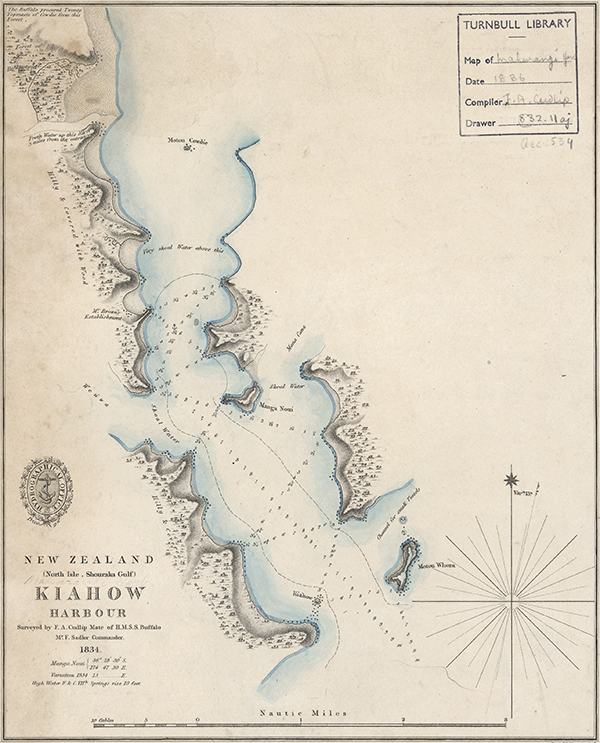
First Useful Chart Mate: First mate of hmss Buffalo gave the Mahurangi Harbour its first useful chart, while extracting spars for the Royal Navy to the detriment of Gordon Browne, who had established his spar station there two years earlier to do precisely that, on contract to the Admiralty. chart Frank A Cudlip
The next year, 1834, saw the first proper charting of the Mahurangi Harbour. It was a by-product of the visit of the storeship hms Buffalo. Her mate, Frank Cudlip, was an accomplished cartographer, and used his time waiting for the spars to arrive by charting the harbour. He also charted the coast north to Cape Rodney, and Raglan Harbour. The chart was published by the Admiralty in 1836 as ‘Maurhangi Harbour’, along with a chart of the ‘Shouraka Gulf’, incorporating the work of Cook, Downie, D’Urville and Cudlip. Surveyor-General, Felton Mathew, had Cudlip’s chart when he anchored in the ‘bay of Mauranghi’ on 2 April 1840 and wrote:
There is already in existence a chart of this bay published under the authority of the Admiralty.
He confined himself to description, although he went to the head of the tide, leaving the first description of the upper harbour and river—Cudlip’s chart did not extend upstream of Dyers Creek. Mathew claimed for these mangrove-enclosed reaches:
…a uniform depth of water of two fathoms at low water, for a distance of about five miles.
Cudlip took his sextant and chronometer to ‘Manga Noui’Casnell Island and took sun shots. For the first time, he put Mahurangi on the map of the world by writing on his chart the latitude and longitude of the island. He was one mile out on the first, and two miles out on the second, a creditable effort with his instruments.
Cudlip left some odd names on his chart. ‘Weuwa’ seems to be an attempt at Huawai, the correct name for the Pukapuka estuary. The quaintest is ‘Mana Cana’ for Te Kapa. My wife has offered a brilliant explanation: it was his version of Matakana. I believe as he rowed past, he pointed northeast up the estuary asking for its name, but his Māori guide interpreted the gesture as ‘what lies in that direction?’, and replied, Matakana. These two oddities survived on the chart until 1965. This theory is confirmed by the appearance of ‘Mana Cana’ on an early gulf chart on what is undoubtedly the Matakana River. Cudlip left his captain’s name on the eastern Mahurangi headland (misspelt as ‘Saddler Point’). His own name was given to the western headland (‘Cudlip Head’) on the ‘Shouraka Gulf’ chart of 1836. This name survived until 1965, but sadly it has disappeared from subsequent charts.
A monumental survey of the New Zealand coastline was made by Captain Stokes of the hms Acheron. This barque-rigged paddle steamer of 760 tons was sent out to New Zealand by the Admiralty, and spent the years 1848–55 at the task, off and on. The Acheron arrived in Auckland on 17 November 1848, and spent some weeks surveying the Hauraki Gulf before leaving for Wellington on 22 January 1849. During that time Governor Grey made resources available, including the decked boat Māori, which under the command of George Henry Richards, was sent off to survey in detail the western shore of the gulf “with its adjacent isles from Port WangapraoWhangaparāoa Bay to Cape Rodney”, and to meet the Acheron at Great Barrier Island. Thus Commander Richards should have surveyed Mahurangi. In fact, the systematic charting of Mahurangi was carried out by the Acheron’s assistant ship, hms Pandora, a small brig. It was employed under Captain Byron Drury in the last three years of the survey, to complete the work by charting the small harbours and bar-protected rivers of the North Island. Captain Drury had already seen adventure in a naval career. He had sounded the Yangtse River under fire for the entry of the British fleet. The Pandora arrived in Auckland on 17 September 1851, and finished off the detached parts of the gulf. Heaphy’s land survey of the Mahurangi, in progress by 1852, would probably have contributed to this chart. The work of Drury stood until early this century. It remains the basis of an Admiralty chart of the gulf, dated 1891. This shows land contours and much more extensive soundings of the Mahurangi than Cudlip’s chart.
The Acheron survey put Hauraki Gulf accurately on the world map by fixing astronomically to six figures, the latitude and longitude of four reference points at Auckland, Whangaparāoa, Kawau and Great Barrier. It also measured the tide ranges and magnetic deviation—then, 14° East.
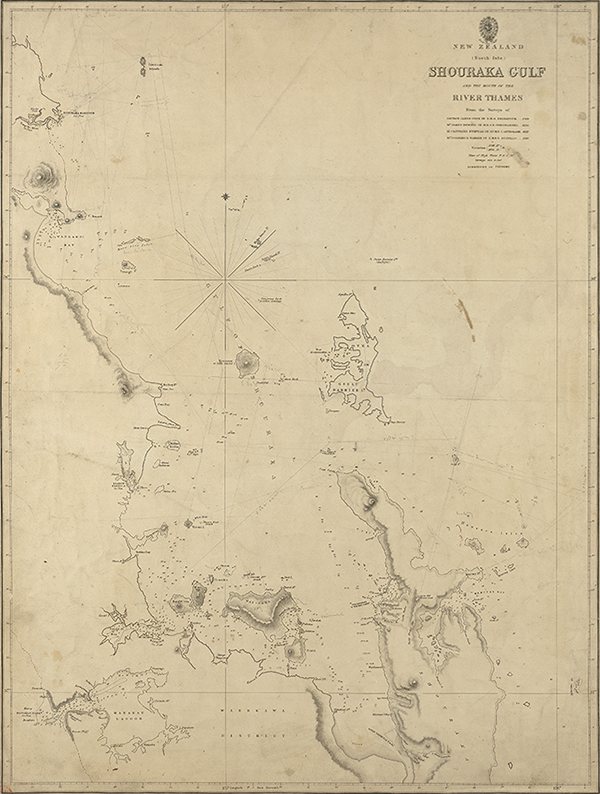
Downie Lacking Detail: Being out of range of Captain James Cook’s chart, Captain James Downie’s, 52 years later, was the first, commanding the hmss Coromandel, to produce a chart that included the Mahurangi Harbour, all be the detail somewhat scant. Otherwise, we should be grateful for the Shouraka spelling, given that a, probably earlier, iteration of this chart risked usurping the indigenous name for the gulf, Hauraki, with River Thames. chart Captain James Downie
Captain Drury stayed on in Aotearoa. Several exquisitely drawn early charts bear his name. He also produced the first New Zealand Pilot, in 1856. The New Zealand Almanac of 1862 reproduces the sailing directions for Mahurangi from Drury’s ‘new edition’. The tides around Kawau are first described:
The flood tide runs to the westward through the N Channel, sweeping around Kawau Bay and down to southward; on the E side of Kawau the tide runs to the southward, and with considerable strength near the SE extreme. The ebb tide runs to the northward on both sides of the island and out to the eastward through the N Channel at the rate of 3H knots during springs.” In directions for finding the tides around Auckland, it is stated that “Spring tides are the highest and occur at or about new or full moon. Neap tides are the lowest and occur at first and last quarters. Ebb tide lasts on average 7G hours, and flood tide about 5G hours.
The landmark for entering Mahurangi:
WhoraSaddle Island lies NW by W, 6H miles from the extreme of WangaproaWhangaparāoa Peninsula and W by S 1¼ miles from the S end of Ora IslandMotuora. Vessels bound to Mahurangi should steer to the southward of both these islands, and passing the S end of WhoraSaddle Island within a ¼ mile, a course should be steered direct in between the heads. Strangers entering Mahurangi Harbour are liable to mistake the arm which runs immediately N from Sadler Pt for the main harbour: there is shoal water however in this armTe Kapa a short distance within the line of the points. The direct course is NW½W for the Peninsula of Manganui which is high and makes as an islandCasnell; it bears NW H W from the N head, distance 1½ miles. Between this peninsula and the S shore is the best anchorage for large vessels, with the centre of Manganui bearing N by E in 7 fathoms, muddy bottom; the channel here is scarcely ½ mile wide. Westward of Manganui is another armPukapuka running to the NNW with shoal water between the entrance points. There is anchorage in 5 fathoms ¾ mile above Manganui; immediately above this anchorage it shoals with flats drying out at low water. Boats can ascend the river several miles with the tide.
It is high water at Mahurangi on full and change days at 7 hours 0 minutes and the tides rise 7 to 10 feet.
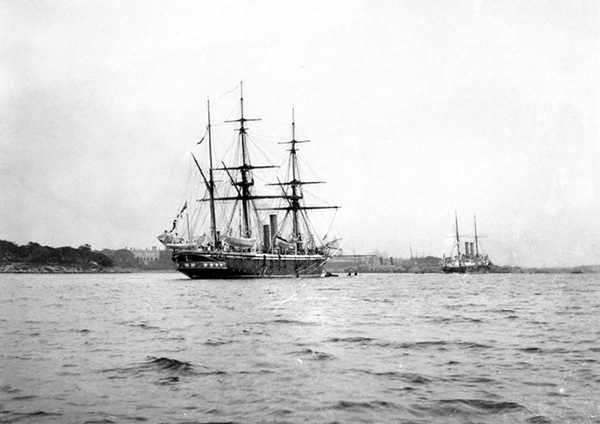
Steam-Powered Survey: With her lack of sheer, not the most graceful naval vessel ever, but the Osprey-class war-sloop hms Penguin, enabled her commander, Captain Willoughby Pudsey-Dawson, to produce a chart of the Mahurangi Harbour regarded by those lucky enough to own a copy, as a work of art. He was also, judging by this and a number of other, sharper, images attributed to him, an accomplished photographer. photographer Captain Willoughby Pudsey-Dawson
In those days before weather forecasting, the almanac also offered this succinct account of the “Winds, Weather and Meteorology” for North Cape to Mercury Bay, again from the New Zealand Pilot. Present day sailors on the Northland cruising grounds will recognise much truth in it, and may still find it of value:
During the summer months, October to March, the NE or regular sea breeze is constant; it sets in about 10 am and gradually dies away towards sunset, when it is succeeded by the westerly or land wind. Should the sea breeze continue after sunset and the sky become cloudy, it will generally increase to a fresh gale, accompanied with heavy rain lasting several hours, when the wind will suddenly shift to the westward and the weather become fine.
These regular land and sea breezes cannot be depended on during the winter months, and the general wind seems to be from NW to SW; a north wind with cloudy weather will usually terminate in a gale accompanied with rain, though of short duration.
NW winds generally blow strong with heavy rain and seldom last more than 24 hours; the general shift follows the course of the sun. With the wind at the west the weather is unsettled and squally, but immediately it veers to WSW and SW, which it almost invariably does, fine settled weather can be expected to last for several days.
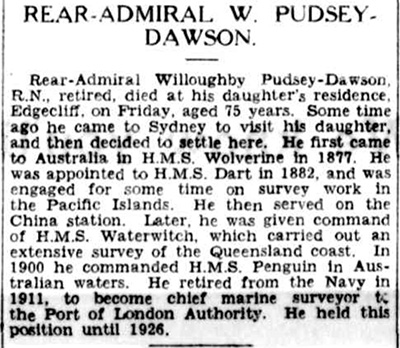
Artist and Commander: Commanding hms Penguin, Willoughby Pudsey-Dawson, then Captain Pudsey-Dawson—who rose to the rank of Rear-Admiral, prior retirement to Australia, where he surveyed much of the continent—bestowed an enduring work of art on the Mahurangi Harbour. image National Library of Australia
A strong easterly or SE gale may be looked for about once in six weeks; it generally occurs about the time of the moon’s full or change, and is accompanied by rain and thick weather, lasting from 2–3 days; this wind is preceded by a high barometer and generally veers round by northward to SW.
There is likewise a SE wind, exceedingly cold, with a clear sky and fine settled weather, which frequently continues for several days, terminating in a calm or shifting to SW. Westerly gales generally die away at sunset within a short distance of the shore; their continuance is indicated by a sensible fall in the barometer.
With the survey ship hms Penguin, Captain Willoughby Pudsey-Dawson revised the chart from Tiritiri Matangi Island to Cape Rodney in 1904–5. This is the most beautiful chart of all. Engraved in 1906, it is a work of art in its own right. Its scale of two inches to the mile allows fine detail, land contours and even houses, and a profusion of soundings. This chart sold until 1965. The modern fathom chart that replaced it—last edition, 1974—was based entirely on the Penguin soundings, simplified. However, to mark metrication of the chart, the Mahurangi Harbour was completely resurveyed in 1975. Thus, the current metric chart is indeed a new chart.
By comparing soundings on Cudlip’s chart of 1834 with those on the Penguin chart of 1904, one may draw conclusions on siltation in the Mahurangi Harbour in the last century, and by comparing the Penguin and metric charts, likewise observe changes in this century. This is done later.

Thank you for this well written article. I would like to add a personal footnote to this story of the navigational history of New Zealand.
Willoughby Pudsey Dawson was my 1st cousin three times removed. He came from a family with a long line of military and naval history. On the Dawson side through his father Richard Pudsey Dawson, he was the 20th great-grandson of King Edward III. On his mother’s side, through Louisa Elizabeth née Shuttleworth, he has a close cousinship with William Shuttleworth Holden who was a midshipman aboard the hms Resolution during Captain James Cook’s third voyage, 1776–79.